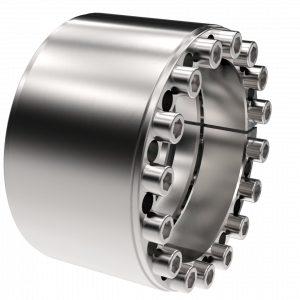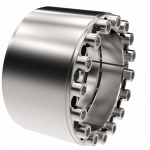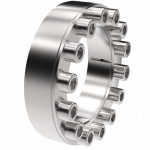TAS Schäfer Stainless Steel Locking Assemblies
Rust-proof clamping sets with friction-free fastening and easy assembly/disassembly for transmittable torque from 168Nm to 128,248Nm.

Benefits
- Easy Assembly and disassembly
- Transmittable torque of 168Nm to 128,248Nm
- Nominal diameter of 17mm to 240mm
- Stainless steel, rust-free form
The 3000 S2 series locking assemblies are internally clamping frictional connecting elements for backlash-free fastening of hubs on shafts. Consisting of two conical pressure rings and a single clamping sleeve. The conical pressure rings are pulled onto the conical surfaces of the clamping sleeve by tightening the clamping screws to the specified tightening torque and generate a radial force both inwards and outwards at the contact surfaces. This radial force produces a frictional connection between the cone clamping element and the shaft as well as the hub.
By means of this frictional shaft-hub connection, torques and axial forces can be reliably transmitted between the shaft and hub. Depending on the design, bending moments can also be transmitted with this type of connection. Compared to externally clamping connections such as “shrink discs”, locking assemblies are located within the force flow. This means that the transmitted forces are passed from the shaft through the locking assemblies into the hub or vice versa. The locking assemblies itself must therefore withstand the forces, as it is the connecting element between the shaft and the hub.
Stainless steel locking assemblies come in two forms currently: The 3012 S2, and the 3020 S2. Each are suited for a separate niche. For more information, refer to their entries in TAS Schäfer’s product catalogue.
Benefits of 1.4122 Stainless Steel
Shaft-hub connections made of stainless steel are increasingly used in industry today. On the one hand, this is due to the fact that the demands on the components in certain industries are becoming ever higher, but at the same time, the processing of stainless steel has also become easier. Stainless products in drive technology are particularly characterised by their resistance to chemically aggressive substances. They are therefore increasingly used in the food and packaging industries, maritime technology, laundry technology or in laboratory equipment. In general, stainless products are used wherever the increased risk of corrosion and purity are important criteria.
The Standard stainless steel 1.4122 used is martensitic with good corrosion resistance and excellent wear resistance. If the product is to be used in a more aggressive environment, the 1.4571 material is preferred. This stainless austenitic steel offers very good corrosion resistance and is also suitable for cryogenic and elevated temperatures up to 550°C.
However, it should be noted that despite good mechanical properties, products made of stainless steel achieve lower transmission values than comparable products made of standard materials such as 42CrMo4+QT. In addition to the mechanical properties of the steel, the mechanical properties of the clamping screws are decisive for this. The strength values of stainless steel tension bolts are significantly lower than the strength values of high-strength steel bolts. As a rule, however, the transmission values of stainless products are sufficient for their use. Should this not be the case, special solutions can be implemented quickly and easily.
Products
Resources



